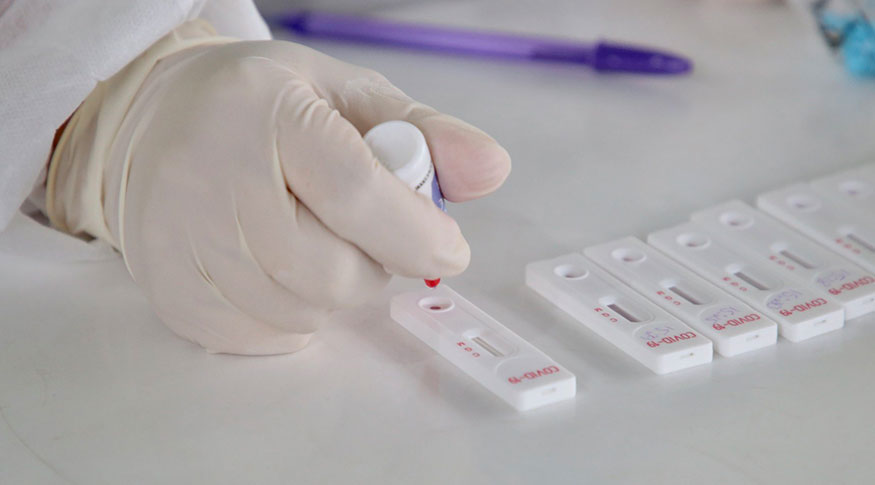PNAD COVID19
10.4% of population were tested for Covid-19 until September in Brazil
October 23, 2020 09h00 AM | Last Updated: October 27, 2020 05h36 PM
Highlights
- 21.9 million persons were tested to diagnose for Covid-19 until September, the equivalent to 10.4% of the Brazilian population.
- The highest percentage of tests is among persons with higher income: 25.1% of the persons who earn four or more minimum wages.
- Among the persons who were tested, 4.8 million were diagnosed with Covid-19.
- The Federal District (22.2%) was the Federation Unit with the highest percentage of persons who were tested, followed by Piauí (17%) and Goiás (16%). Pernambuco registered the lowest one (6.8%).
- In September, 9.2 million reported to have any symptom of flu-like syndrome, which represents 4.4% of the population.
- The percentage of households where a resident received any aid to fight against the effects of the pandemic was 43,6% in Brazil, being higher in the North (59.8%) and Northeast (58.8%).
- Unemployed population hits 13.5 million personsand unemployment rate rises to 14%, two records in the time series of the monthly PNAD COVID19.

The number of persons who were tested to diagnose Covid-19 reached 21.9 million in September, the equivalent to 10.4% of the Brazilian population. Of them, 4.8 million were tested positive. These data are from the monthly edition of PNAD COVID19, released today (23) by the IBGE. In August, 17.9 million had been tested and 3.9 million were diagnosed with the disease.
"Between August and September, more four million people were tested and nearly more one million were tested positive," says Maria Lucia Vieira, coordinator of the survey.
By age group, the highest percentage of persons who were tested to detect Covid-19 was between 30 and 59 years of age (14.3%), followed by the groups between 20 and 29 years (12.1%) and from 60 years of age onwards (9.2%). Among the persons without education up to incomplete primary school, 5.5% were tested and, among those with higher education or post-graduation, 21.5%.
The percentage of those tested to diagnose the disease is higher in the group of persons with higher per capita household income, reaching 25.1% among those in the range from four or more minimum wages. In the same period, only 5.9% of the persons in the range of less than half minimum wages were tested.
Three types of tests are approached by the survey: SWAB, in which the material is collected with a cotton swab from the mouth and/or nose; the quick test, in which blood is collected through a fingerstick; and the exam in which blood is collected through an arm vein. Of the 21.9 million persons who were tested, 8.8 million used SWAB and, of them, 2.3 million were diagnosed positive.
The Federal District (22.2%) was the Federation Unit with the highest percentage of tests, followed by Piauí (17%) and Goiás (16%). The lowest percentages were registered in Pernambuco (6.8%), Acre (6.9%) and Minas Gerais (7.8%).

The survey also pointed out a drop in the contingent of those who reported to have any symptom of flu syndromes. In September, 9.2 million persons reported to have any of the symptoms approached by the survey, like cough, fever and difficulty to breathe. This figure represents 4.4% of the Brazilian population. When the survey began on May, 24 million or 11.4% of the Brazilians showed any of the symptoms.
In 29.9 million households, a resident received an emergency aid
In September, the percentage of households where a resident received any aid to fight against the effects of the pandemic was 43.6%. It had been 43.9% in August. 29.9 million were benefited in September against 30.1 million in August. The average value of the benefit received by the population was R$894 per household.
"The percentage of households where a resident received an emergency aid remained stable over the last four months," says Vieira. Among the types of aid approached by the survey, the emergency one, destined to informal workers, individual micro-entrepreneurs (MEIs), free lancers and those unemployed, and the supplementation of the Federal Administration through the Emergency Program of Employment and Income Maintenance stood out.
The North (59.8%) and Northeast (58.8%) were the regions that recorded the highest percentages of households receiving aids. Among the states, Amapá (68.4%) was the state with the highest proportion, followed by Maranhão (63.7%) and Pará (63.3%).
"The regions that have more households with persons receiving aids are still the North and Northeast, as their people are more suitable to receive aids. This percentage remained stable in all the Major Regions," says the researcher.

Unemployed population and unemployment rate were record
PNAD COVID19 estimated the employed population in Brazil at 82.9 million people in September, an increase of 1% over the previous month and a retraction of 1.7% over May. "The employed population was of 84.4 million in May and dropped until July, when it resumed the positive changes, reaching the contingent of 82.9 million in September. It is still below the figure of May, but it showed a slight recovery in August and September," says the researcher.
The unemployed population, which was of 10.1 million in the beginning of the survey, changed to 13.5 million in September, a record in the time series. "The unemployed population grew along all these months. This growth is attributed both to the persons who lost their jobs until July and to the persons who began to leave the social distancing and press the labor market," explains Vieira.
As a result, the workforce, which sums the employed with the unemployed population, changed from 94.5 million in May to 96.4 million in September. The number of persons out of the workforce fell 1.5% over August, hitting 74.1 million. The unemployment rate changed from 13.6% in August to 14%, the highest one in the time series of the survey.
Of the 82.9 million employed persons, 93.5% were not away from work. Of them, 10.4% were working remotely.




















